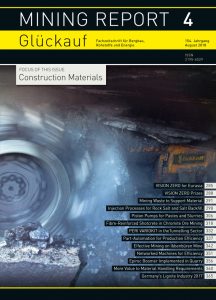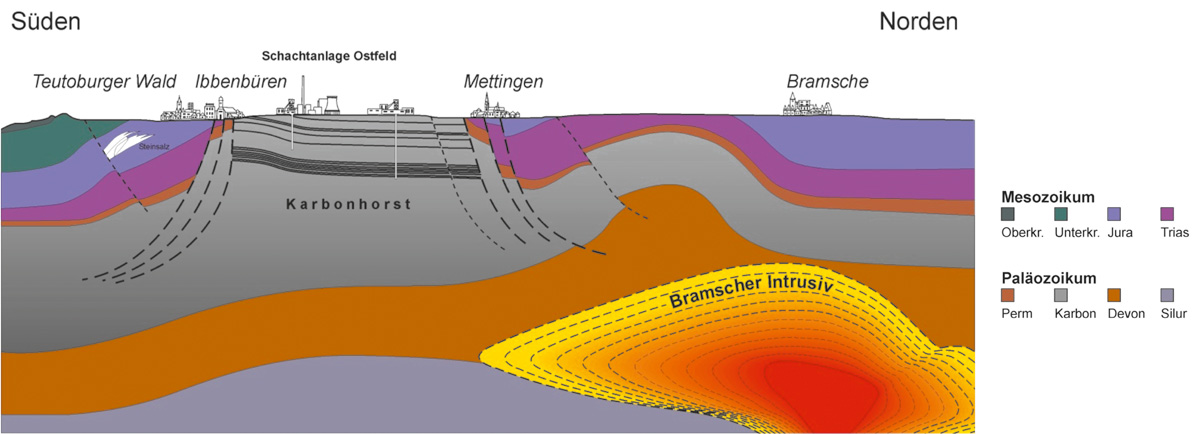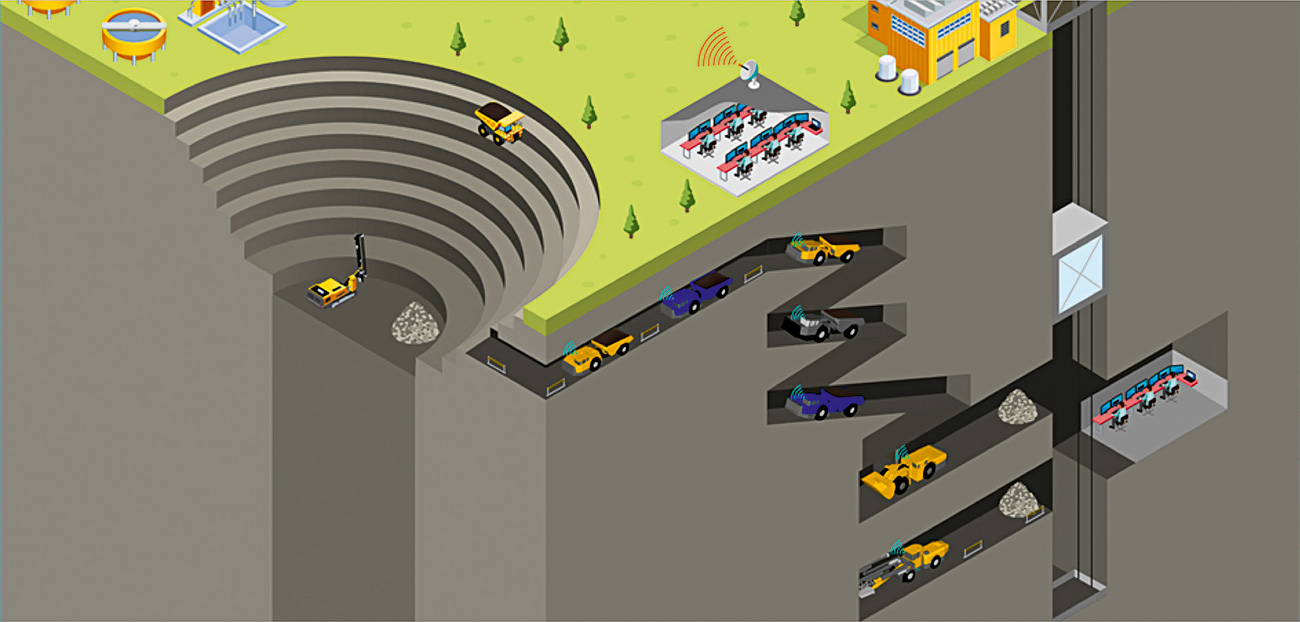It is hard to imagine how the deep mining industry would function without access to the construction materials that are so essential for stabilising underground cavities. The formulation chosen for these products will differ significantly from one project to another according to the required setting properties and strength development. Given their importance for the operating efficiency of a mining undertaking, and for the safety of the underground personnel, these materials and the associated technology will provide the main focus for this edition of Mining Report Glückauf, which presents the latest developments in this field and describes some of the placement and installation techniques used.
Read moreWith my best regards // Mit freundlichem Glückauf
Dipl.-Ing. Andreas-Peter Sitte
Chief Editor Mining Report Glückauf, Essen
From Mining Waste to Load-Bearing Support Material
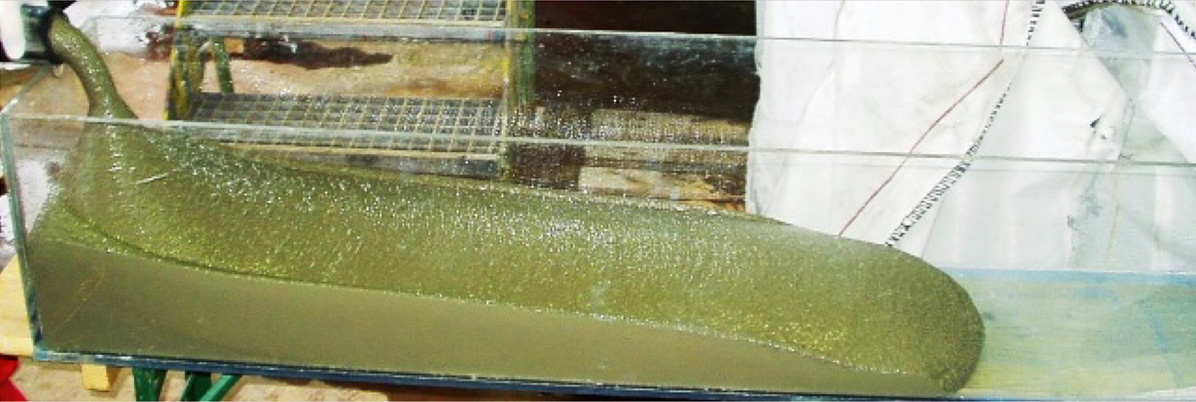
Fig. 1. Flow test with a non-sedimenting stowing material. // Bild 1. Fließversuch mit einem sedimentationsstabilen Versatzbaustoff. Photo/Foto: DMT
Underground stowing material has to meet all kinds of divergent requirements. From an economic viewpoint the overall costs should be kept as low as possible, while from a stowing point of view the material as a load-bearing element often has to satisfy very high standards. Moreover, the preference is generally to use discard from the colliery itself, as this will reduce the cost associated with tipping and/or disposal.
The transition from residual waste to load-bearing support material is a complex process that combines support engineering, material technology and process-related elements. These individual aspects will be described in detail in order to explain the basic approach used and to highlight the interdependent nature …
Author: Dipl.-Ing. Bernd Pflüger, Head of Testing Institute for Concrete, DMT GmbH & Co. KG, Essen/Germany
Read moreInjection Processes for Rock Salt and Salt Backfill – Tried and Tested Materials and New Developments
According to the classic approach, fissure or pore systems in solid rock or backfill are to be injected with particle-laden, and thereafter particle-free material when a high level of impermeability is required. The suspensions used in the salt and potash mining industries are usually in the form of magnesia binders. Waterglass is also frequently employed as a particle-free injection medium because of its capacity to react with salts and saline solutions to form a solid. Waterglass reacts with magnesium oxide (MgO) and many other substances containing magnesium. This served as a basis for developing a new type of injection medium. Unlike magnesia binders these mixtures move out along their flow paths …
Authors: Dr rer. nat. Hans-Joachim Engelhardt, Thomas Meyer, Holger Schmidt, BGE TECHNOLOGY GmbH, Peine, Matthias Heydorn, Jonas Weber, BGE Bundesgesellschaft für Endlagerung mbH, Schachtanlage Asse, Remlingen
Read moreHydraulic Driven Piston Pumps for the Transport of Pastes and Slurries in the Mining Industry
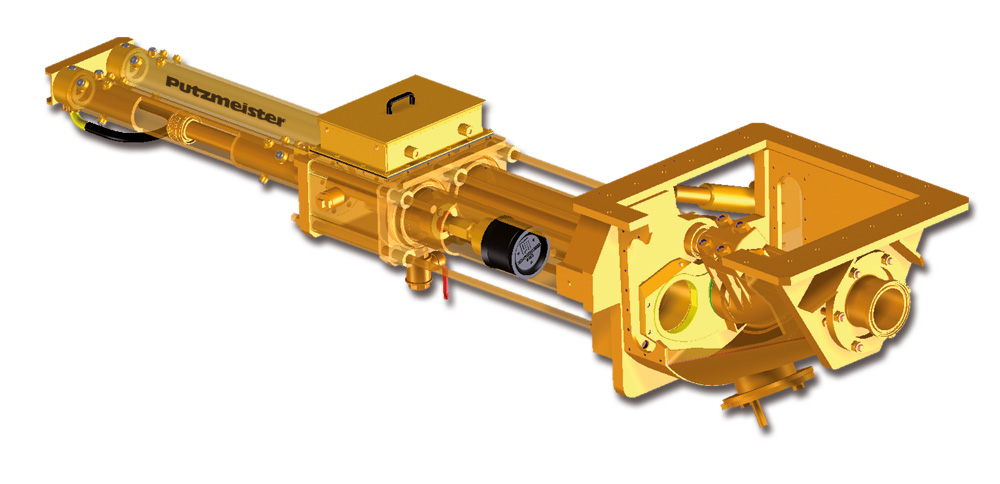
Fig. 5. KOS series high-density solids pump with hopper and S-transfer tube (2). // Bild 5. KOS-Rohrweichenpumpe für Dickstoffe, ausgestattet mit Aufgabetrichter und S-Rohr (2).
More and more mines are using double piston pumps for conveying pastes, cakes and slurries. Stiff pastes are normally used for the stabilization of underground workings. Cement and ash are added to create a construction material with sufficient strength. For tailings and ore transportation above ground, slurries are produced and transported over long distances to deposits or preparation plants. In this article the author shows various job sites around the world where different materials are pumped, providing the relevant information about the pastes and slurries that were pumped, information about the paste preparation plants, advantages of the paste systems and when to use which type of piston pump.
Author: Dipl.-Ing. Peter Peschken, Putzmeister Solid Pumps GmbH, Aichtal/Germany
Read moreChromite Ore Mining in Kazakhstan – Experiences with Fibre-Reinforced Shotcrete

Fig. 1. Chromite ore mine Donskoy GOK, Chromtau, Kazakhstan – distance between service shaft (left) and ventilation shaft (right) approx. 4.5 km. // Bild 1. Chromerzmine Donskoy GOK, Chromtau/Kasachstan. Die Entfernung zwischen Serviceschacht (l.) und Wetterschacht (r.) beträgt ca. 4,5 km. Photo/Foto: SBK
In the Donskoy Mine GOK in Chromtau/Kazakhstan, the TOO Schachtbau Kasachstan, a joint subsidiary of the German companies Schachtbau Nordhausen GmbH and Thyssen Schachtbau GmbH is driving a roadway in tricky geology with a small cross-section by means of New Austrian Tunnelling Method (NATM). Apart from the application of suitable engineering, the innovative shotcrete with polymer fibre reinforcement and consistent quality assurance in particular contributes towards ensuring that requirements are fulfilled.
Authors: Dipl.-Ing. Olaf Schmidt, Projektleiter, stellv. Generaldirektor, und Dipl.-Ing. Eduard Dorn, Generaldirektor, TOO SCHACHTBAU Kasachstan, Almaty/Kasachstan
Read morePERI VARIOKIT in theTunnelling Sector: A Special Application in Formwork Construction
A key indicator regarding the efficiency of formwork systems is their suitability for special applications. More specifically, the cost-effectiveness depends largely on how much the work processes differentiate for different applications and how high the ratio of special components is relative to the standard components of the system. In this context, PERI GmbH, Weissenhorn/Germany, has developed the VARIOKIT, an engineering construction kit that has a high degree of consistency across all types of applications – in terms of its assembly logic as well as the type and quantity of the basic components required.
Author: Dipl.-Ing. Hary Maucher, Project Manager, Technical Office Germany and Central Europe, Competence Center Infrastructure, PERI GmbH, Weissenhorn/Germany
Read morePart-Automation Makes for Greater Production Efficiency
The RAG-managed Prosper-Haniel colliery in Bottrop/Germany, has some very impressive equipment operating on its high-performance coal faces 1,200 m below ground. These underground workings, where miners have been busy digging out the coal, have been the scene of some rapid technological developments over the last five decades. 50 years ago the only way to find out what was going on down there was to travel down in the cage and see things for yourself. However, advances in information technology have brought about a huge change in the operational processes. This paper will attempt to describe an automation system that RAG Mining Solutions has developed in collaboration with RAG Deutsche Steinkohle with the aim of interlinking the various modules that make up the longwall face installation. This part-automated face installation serves as an effective safety system for the coal winning team and thanks to the computer-supported visualisation …
Author: Bettina Pielka B. Sc., Referentin Öffentlichkeitsarbeit, Bergwerk Prosper-Haniel, RAG Aktiengesellschaft, Essen
Read moreHighly Effective Mining of Anthracite Coal on the Ibbenbüren Mine
The Ibbenbüren mine produces coal under the special conditions of large depth and low-thickness seams with high methane content with the risk of gas and gas/coal outbreaks. In this essay the path to a modern, high-performance mine under these conditions is described. Special emphasis is given on the roof support and plowing technology (Gleithobel) in view of the development up to the automation, which is essential to increase performance and miners´ safety. Measures for occupational safety, health protection and employee-based improvement processes are presented as essential steps on the way to the high-performance mine.
Author: Dr.-Ing. Heinz-Werner Voß, Sprecher der Geschäftsführung, RAG Anthrazit Ibbenbüren GmbH, Ibbenbüren
Read moreDigitisation in the Mining Industry: Networked Machines Making for Greater Efficiency
Industry 4.0 is now being introduced into the mining sector in an attempt to save valuable time and money. This helps speed up the workflow and improve safety standards at mines. The following paper discusses the progress to be made in this area and what is already possible today.
Author: Christel Füllenbach M. Sc., Business Line Manager Mining and Rock Excavation Service, Epiroc Deutschland GmbH, Essen/Germany
Read moreEpiroc Boomer E1C-DH Implemented in a Quarry
Truffer AG, Vals/Switzerland, is a company extracting Vals Quartzite in its own quarry. The material is further processed in Truffer’s factory located in Vals. Founded in 1983, Truffer is now one of the leading stone processing companies in Switzerland. The firm employs 60 workers and fabricates a wide range of natural stone products, which are used for projects around the globe. Previously Truffer only used surface equipment, but since fall 2017 a Boomer E1C-DH of Epiroc, is in the operation for blasting dimension stone blocks. Usually this boomer is used in underground or tunneling operations.
Author: Antje Matthäus M. Sc., Product Manager Capital Equipment Underground, Epiroc Deutschland GmbH, Essen
Read moreContinuing to Add Value Across a Wide Variety of Material Handling Requirements

Fig. 1. TAKRAF’s material handling system for waste material in Mexico with overland conveyors and stacking equipment. // Bild 1. TAKRAF’s Abraum-Massengutumschlagssystem in Mexiko mit Förderbandanlagen und Bandabsetzern. Photo/Foto: TAKRAF
More than a century after their invention, belt conveyors remain a key element in delivering bulk material to the process and production of products and material that feed the worlds burgeoning economies. The technology has evolved significantly throughout the 20th century and continues developing to keep pace with the demands of the 21st century. Today’s belt conveyor systems are capable of continuously transporting high volumes of material efficiently over long distances and challenging terrains negotiating through curves and rough relief areas. Recent conveyor installations have exceeded 20 km in length and have had multiple thousands of tons per hour in capacity, and up to 25 MW in installed power. Although generally having greater initial capital costs, these systems are able to recover them through significantly less operational costs …
Author: Gerhard Schmidt, Vice President, Takraf USA Inc. Denver/USA
Read moreThe German Lignite Industry in 2017
Germany’s domestic lignite output decreased by 0.2 % from 171.6 mt to 171.3 mt between 2016 and 2017. 2017’s extracted lignite had a net calorific value of 52.5 mtce. 153.2 mt, or almost 90 %, of that output were used in utility power plants supplying the general public. This translates into a decrease of 1.3 % compared to the previous year. 14.7 mt were used in the factories of the lignite mining industry for the manufacture of solid products. 2.5 mt were used to generate electricity in mine-mouth power plants. 0.9 mt accounted for other sales of raw lignite and changes in stocks. Lignite’s contribution to Germany’s total gross electricity production amounted to 22.5 % in 2017.
Authors: Dipl.-Volkswirt Uwe Maaßen, Managing Director, The German Coal Industry‘s Statistical Office, Bergheim/Germany, and Dr. rer. pol. Hans-Wilhelm Schiffer, Executive Chair World Energy Resources, World Energy Council, London/Great Britain
Read more
